Neuromuscular ultrasound findings in carpal tunnel syndrome with symptoms mainly in the nondominant hand
Abstract
Background
Carpal tunnel syndrome (CTS) may be associated with structural lesions or anatomical variations at the wrist, especially in patients whose symptoms are more severe in, or limited to, the nondominant hand. The aims of this study were to identify the type and frequency of structural abnormalities and anatomical variations, and to demonstrate the contribution of ultrasound in this subgroup of CTS patients.
Methods
A retrospective chart review was performed on all patients referred to the electromyography laboratory who fulfilled the diagnostic criteria for CTS and who underwent neuromuscular ultrasound.
Results
Of 114 CTS patients with symptoms mainly in nondominant hand, 51 (44.7%) had structural abnormalities or anatomical variations detected by ultrasound. In multivariable analysis, symptoms mainly in the nondominant hand and a body mass index (BMI) <30 kg/m2 were the only independent variables significantly associated with structural findings, odds ratios 2.3 (P < .001) and 1.9 (P = .006), respectively.
Conclusions
Neuromuscular ultrasound, in addition to electrodiagnostic studies, should be considered in all CTS patients with symptoms more severe in nondominant hand as a significant number have abnormal structural abnormalities or anatomical variations that may be causative or change the therapeutic approach.
Abstract
CONFLICT OF INTEREST
None of the authors has any conflict of interest to disclose.
Open Research
DATA AVAILABILITY STATEMENT
Research data are not shared.




